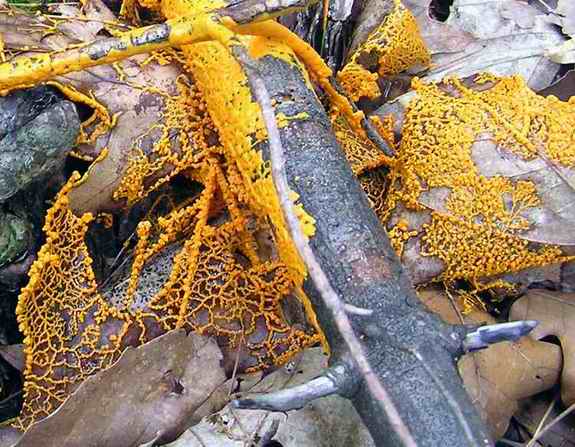|
Return to Hiker's Notebook Home Page
Common Name: Many-Headed Slime, Grape-Cluster Slime - The mass of the slime dissociates into distinctive nodules that are "many-headed" or "grape-clustered". Scientific Name: Physarum polycephalum - Species name from Greek poly meaning many and kephalikos (Latin cephalicus) meaning head; literally many-headed.
Slime molds or myxomycetes were once considered fungi in the subkingdom Thallophyta of the Kingdom Plantae. They were afforded their own division Myxomycophyta, the true slime molds (myxo is from the Greek muxa meaning mucus and myco from the Greek mykes meaning fungus, literally slime fungus). Their association with fungi was due to the formation of spores during one portion of their complex life cycle. About four decades ago, biologists came to accept the division of all life into five principle kingdoms: the original Plantae and Animalia with the addition of Fungi, Monera for bacteria and Protista for life forms that were considered evolutionary ancestors of all other multicellular life forms. According to this definition, slime molds are Protists, having characteristics of plants, animals or fungi in one of the stages of their complex life cycle.
The prominent, vegetative phase of the life cycle of the slime mold is the plasmodium, consisting of a mass of protoplasm; an enormous single cell with thousands of nuclei defined generically as a syncytium (having multiple nuclei in a common cytoplasm as in the striated muscle fibers of animals). Plasmodia preferentially grow in the darker recesses under the bark of decaying trees and the leaf litter of the forest floor, as they have a high photosensitivity; that is they are averse to light.
The plasmodium can grow very large and commonly assumes a lacy network of branches that is often brightly colored. It moves over the ground like a giant amoeba in search of its primary food sources: bacteria, spores and decaying organic material. The food is digested in cavities in the protoplasm called vacuoles; waste products and undigested particles are left behind as the slime surges forward. Laboratory studies of P. polycephalum have revealed that the protoplasm streams with a velocity greater than that of any other organism. The streaming occurs in one direction for a short period of time, often less than a minute, and then reverses to flow in the opposite direction. This back and forth streaming occurs continuously during the active growth period.
The rapid growth and streaming behavior of myxomycetes has resulted in some interesting interactions with the Homo sapiens species. In 1973, large yellow growths were noticed on some suburban lawns in Dallas, Texas, causing some residents to become alarmed. Fearing that an alien species was encroaching on the city, they summoned the fire department to eradicate it. Unfortunately, the high pressure water served only to spread and accentuate the growth of the yellow substance. As the demand for National Guard action against the invasion reached the governor's desk, a scientist was called in who identified the alien blob as slime mold, probably either P. cinereum (Ashy Physarum) or Fuligo septica, Scrambled-egg Slime.
When environmental conditions deteriorate, the plasmodium enters a hardened dormancy stage called sclerotia in which it can remain for many years until appropriate food sources become available. Sporulation, the production of spores, occurs when the plasmodium is stressed by light, heat, high PH or a variety of other environmental factors. Several hours after the inducement, the plasmodium breaks down into nodules, each of which projects a millimeter-length stalk to which is appended a fruiting body of spores. The haploid (having one set of chromosomes) spores disseminate and germinate to produce either an amoeba-like structure or a structure with a whip-like flagellum called a flagellated swarm cell. Two amoeba cells or two flagellated swarm cells then join together to form a diploid (having two sets of chromosomes) zygote which transforms into a plasmodium to complete the cycle.
The Protista Kingdom (sometimes called Protoctista) represents the most primitive form of eukaryote (organisms with cells having nuclei and dividing by mitosis; prokaryotes have no nucleus and reproduce by fission) and consists of four major groups: protozoa, slime molds, unicellular algae and multicellular algae. It is hypothesized that Protists gave rise to all multicellular life, starting about 1.8 Billion years ago. Plants probably evolved from green algae that grew in littoral areas, gradually becoming acclimated to dry land. Animals arose from colonial Protists that evolved to allow for a division of labor among cells. For example, an inward folding of the cell wall gave rise to the development of the digestive tract, a feature unique to the Animal Kingdom. Sponges were probably the first animals, evolving from the choanoflaggellate, a Protist found at the bottom of ponds with a cluster of flagellated cells attached to a stalk. |
